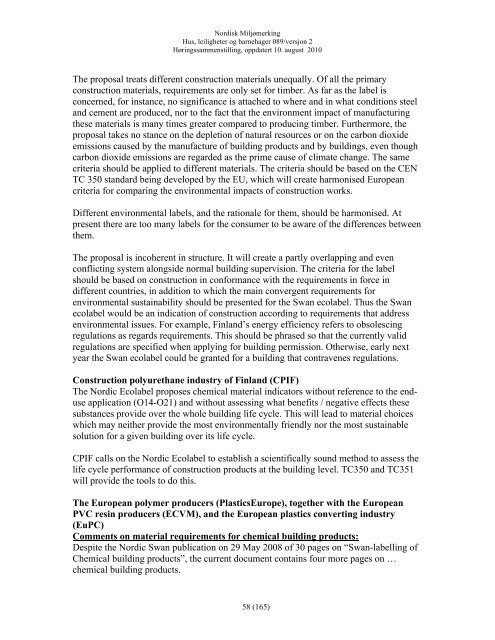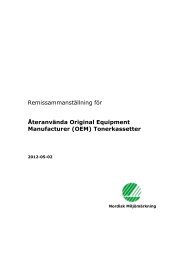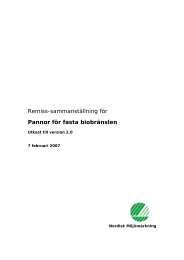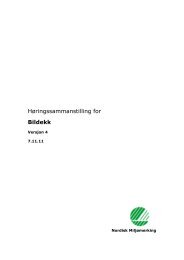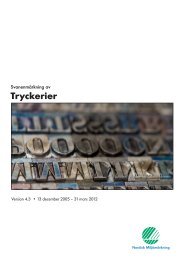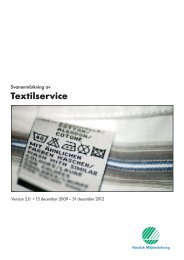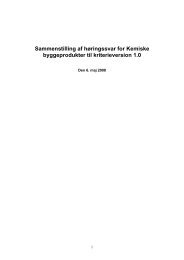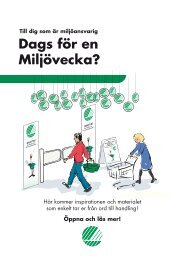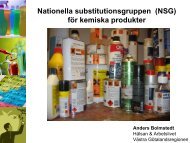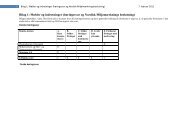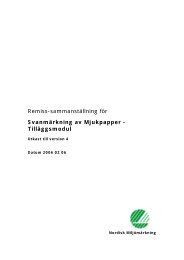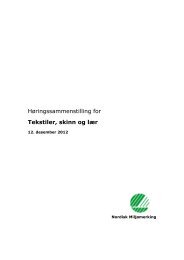Småhus, flerbostadshus och förskolebyggnader - Svanen
Småhus, flerbostadshus och förskolebyggnader - Svanen
Småhus, flerbostadshus och förskolebyggnader - Svanen
You also want an ePaper? Increase the reach of your titles
YUMPU automatically turns print PDFs into web optimized ePapers that Google loves.
Nordisk Miljømerking<br />
Hus, leiligheter og barnehager 089/versjon 2<br />
Høringssammenstilling, oppdatert 10. august 2010<br />
The proposal treats different construction materials unequally. Of all the primary<br />
construction materials, requirements are only set for timber. As far as the label is<br />
concerned, for instance, no significance is attached to where and in what conditions steel<br />
and cement are produced, nor to the fact that the environment impact of manufacturing<br />
these materials is many times greater compared to producing timber. Furthermore, the<br />
proposal takes no stance on the depletion of natural resources or on the carbon dioxide<br />
emissions caused by the manufacture of building products and by buildings, even though<br />
carbon dioxide emissions are regarded as the prime cause of climate change. The same<br />
criteria should be applied to different materials. The criteria should be based on the CEN<br />
TC 350 standard being developed by the EU, which will create harmonised European<br />
criteria for comparing the environmental impacts of construction works.<br />
Different environmental labels, and the rationale for them, should be harmonised. At<br />
present there are too many labels for the consumer to be aware of the differences between<br />
them.<br />
The proposal is incoherent in structure. It will create a partly overlapping and even<br />
conflicting system alongside normal building supervision. The criteria for the label<br />
should be based on construction in conformance with the requirements in force in<br />
different countries, in addition to which the main convergent requirements for<br />
environmental sustainability should be presented for the Swan ecolabel. Thus the Swan<br />
ecolabel would be an indication of construction according to requirements that address<br />
environmental issues. For example, Finland’s energy efficiency refers to obsolescing<br />
regulations as regards requirements. This should be phrased so that the currently valid<br />
regulations are specified when applying for building permission. Otherwise, early next<br />
year the Swan ecolabel could be granted for a building that contravenes regulations.<br />
Construction polyurethane industry of Finland (CPIF)<br />
The Nordic Ecolabel proposes chemical material indicators without reference to the enduse<br />
application (O14-O21) and without assessing what benefits / negative effects these<br />
substances provide over the whole building life cycle. This will lead to material choices<br />
which may neither provide the most environmentally friendly nor the most sustainable<br />
solution for a given building over its life cycle.<br />
CPIF calls on the Nordic Ecolabel to establish a scientifically sound method to assess the<br />
life cycle performance of construction products at the building level. TC350 and TC351<br />
will provide the tools to do this.<br />
The European polymer producers (PlasticsEurope), together with the European<br />
PVC resin producers (ECVM), and the European plastics converting industry<br />
(EuPC)<br />
Comments on material requirements for chemical building products:<br />
Despite the Nordic Swan publication on 29 May 2008 of 30 pages on “Swan-labelling of<br />
Chemical building products”, the current document contains four more pages on …<br />
chemical building products.<br />
58 (165)


